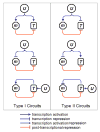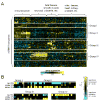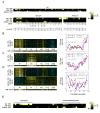MicroRNA-mediated feedback and feedforward loops are recurrent network motifs in mammals
- PMID: 17560377
- PMCID: PMC2072999
- DOI: 10.1016/j.molcel.2007.05.018
MicroRNA-mediated feedback and feedforward loops are recurrent network motifs in mammals
Abstract
MicroRNAs (miRNAs) are regulatory molecules that participate in diverse biological processes in animals and plants. While thousands of mammalian genes are potentially targeted by miRNAs, the functions of miRNAs in the context of gene networks are not well understood. Specifically, it is unknown whether miRNA-containing networks have recurrent circuit motifs, as has been observed in regulatory networks of bacteria and yeast. Here we develop a computational method that utilizes gene expression data to show that two classes of circuits-corresponding to positive and negative transcriptional coregulation of a miRNA and its targets-are prevalent in the human and mouse genomes. Additionally, we find that neuronal-enriched miRNAs tend to be coexpressed with their target genes, suggesting that these miRNAs could be involved in neuronal homeostasis. Our results strongly suggest that coordinated transcriptional and miRNA-mediated regulation is a recurrent motif to enhance the robustness of gene regulation in mammalian genomes.
Figures






Similar articles
-
Integrated analyses to reconstruct microRNA-mediated regulatory networks in mouse liver using high-throughput profiling.BMC Genomics. 2015;16 Suppl 2(Suppl 2):S12. doi: 10.1186/1471-2164-16-S2-S12. Epub 2015 Jan 21. BMC Genomics. 2015. PMID: 25707768 Free PMC article.
-
Computational identification of hepatitis C virus associated microRNA-mRNA regulatory modules in human livers.BMC Genomics. 2009 Aug 11;10:373. doi: 10.1186/1471-2164-10-373. BMC Genomics. 2009. PMID: 19671175 Free PMC article.
-
'Traffic light rules': Chromatin states direct miRNA-mediated network motifs running by integrating epigenome and regulatome.Biochim Biophys Acta. 2016 Jul;1860(7):1475-88. doi: 10.1016/j.bbagen.2016.04.008. Epub 2016 Apr 14. Biochim Biophys Acta. 2016. PMID: 27091612
-
MicroRNA-regulated networks: the perfect storm for classical molecular biology, the ideal scenario for systems biology.Adv Exp Med Biol. 2013;774:55-76. doi: 10.1007/978-94-007-5590-1_4. Adv Exp Med Biol. 2013. PMID: 23377968 Review.
-
Advantage looping: Gene regulatory circuits between microRNAs and their target transcription factors in plants.Plant Physiol. 2024 Dec 2;196(4):2304-2319. doi: 10.1093/plphys/kiae462. Plant Physiol. 2024. PMID: 39230893 Review.
Cited by
-
MicroRNAs: New Biomarkers for Diagnosis, Prognosis, Therapy Prediction and Therapeutic Tools for Breast Cancer.Theranostics. 2015 Jul 13;5(10):1122-43. doi: 10.7150/thno.11543. eCollection 2015. Theranostics. 2015. PMID: 26199650 Free PMC article. Review.
-
Molecular, cellular, and structural mechanisms of cocaine addiction: a key role for microRNAs.Neuropsychopharmacology. 2013 Jan;38(1):198-211. doi: 10.1038/npp.2012.120. Epub 2012 Sep 12. Neuropsychopharmacology. 2013. PMID: 22968819 Free PMC article. Review.
-
Plasticity-related microRNA and their potential contribution to the maintenance of long-term potentiation.Front Mol Neurosci. 2015 Feb 23;8:4. doi: 10.3389/fnmol.2015.00004. eCollection 2015. Front Mol Neurosci. 2015. PMID: 25755632 Free PMC article. Review.
-
RUNX1: A microRNA hub in normal and malignant hematopoiesis.Int J Mol Sci. 2013 Jan 14;14(1):1566-88. doi: 10.3390/ijms14011566. Int J Mol Sci. 2013. PMID: 23344057 Free PMC article. Review.
-
MicroRNA-mediated gene regulation plays a minor role in the transcriptomic plasticity of cold-acclimated zebrafish brain tissue.BMC Genomics. 2011 Dec 14;12:605. doi: 10.1186/1471-2164-12-605. BMC Genomics. 2011. PMID: 22168751 Free PMC article.
References
-
- Acar M, Becskei A, van Oudenaarden A. Enhancement of cellular memory by reducing stochastic transitions. Nature. 2005;435:228–232. - PubMed
-
- Arlotta P, Molyneaux BJ, Chen J, Inoue J, Kominami R, Macklis JD. Neuronal subtype-specific genes that control corticospinal motor neuron development in vivo. Neuron. 2005;45:207–221. - PubMed
-
- Ballas N, Grunseich C, Lu DD, Speh JC, Mandel G. REST and its corepressors mediate plasticity of neuronal gene chromatin throughout neurogenesis. Cell. 2005;121:645–657. - PubMed
-
- Bartel DP. MicroRNAs: genomics, biogenesis, mechanism, and function. Cell. 2004;116:281–297. - PubMed
Publication types
MeSH terms
Substances
Grants and funding
LinkOut - more resources
Full Text Sources
Other Literature Sources

